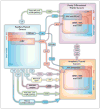Biologic and Clinical Perspectives on Thyroid Cancer
- PMID: 27626519
- PMCID: PMC5512163
- DOI: 10.1056/NEJMra1501993
Biologic and Clinical Perspectives on Thyroid Cancer
Figures



Comment in
-
Biologic and Clinical Perspectives on Thyroid Cancer.N Engl J Med. 2016 Dec 8;375(23):2307. doi: 10.1056/NEJMc1613118. N Engl J Med. 2016. PMID: 27959677 No abstract available.
-
Biologic and Clinical Perspectives on Thyroid Cancer.N Engl J Med. 2016 Dec 8;375(23):2306-2307. doi: 10.1056/NEJMc1613118. N Engl J Med. 2016. PMID: 27959678 No abstract available.
References
-
- Davies L, Welch HG. Current thyroid cancer trends in the United States. JAMA Otolaryngol Head Neck Surg. 2014;140:317–22. - PubMed
-
- Kimura ET, Nikiforova MN, Zhu Z, Knauf JA, Nikiforov YE, Fagin JA. High prevalence of BRAF mutations in thyroid cancer: genetic evidence for constitutive activation of the RET/PTC-RAS-BRAF signaling pathway in papillary thyroid carcinoma. Cancer Res. 2003;63:1454–7. - PubMed
-
- Xing M, Westra WH, Tufano RP, et al. BRAF mutation predicts a poorer clinical prognosis for papillary thyroid cancer. J Clin Endocrinol Metab. 2005;90:6373–9. - PubMed
Publication types
MeSH terms
Grants and funding
LinkOut - more resources
Full Text Sources
Other Literature Sources
Medical
